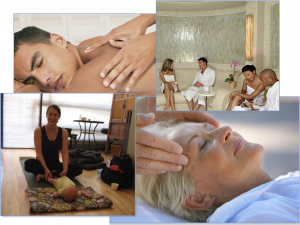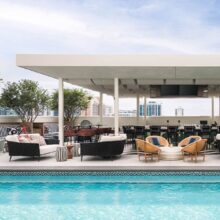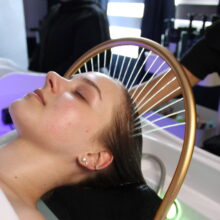9) SpaFinder Spa Trend 2010: Diversity at a Tipping Point – Revisited
- Published: Saturday, November 13th 2010
- in Living Well
 Rereading our Diversity Trend from last year’s trend report it strikes me that the statement, “Spa-going has become so mainstream that the face of the spa-goer will now continue to reflect the wider global population” pretty much sums it up. And I think we gave a fair amount of good examples that were on the radar. However from today’s vantage point, there is one new diversity issue that I didn’t think about at this time last year which I will share with you after you reread the actual trend.
Rereading our Diversity Trend from last year’s trend report it strikes me that the statement, “Spa-going has become so mainstream that the face of the spa-goer will now continue to reflect the wider global population” pretty much sums it up. And I think we gave a fair amount of good examples that were on the radar. However from today’s vantage point, there is one new diversity issue that I didn’t think about at this time last year which I will share with you after you reread the actual trend.
9) Diversity at a Tipping Point
For years analysts have discussed how the spa industry has been attracting new demographics (men, teens, seniors, new ethnic groups). But in 2010 diversity has reached a tipping point in the U.S that in time will likely be followed by the rest of the world: It has fully arrived, and it’s here to stay. Spa-going has become so mainstream that the face of the spa-goer will now continue to reflect the wider global population. Every spa region has its unique “diversity story”, and around the globe both women and men, younger and older generations, and all ethnic groups are hitting the spa. And spas are taking note, with offerings that cater to these diverse groups’ needs and wants. Set to explode: In the U.S. alone, where approximately 78 million baby boomers are poised to enter their 60s, watch for “silver spa-ing” to really take off.
The “diversity story” for the global spa industry takes diverse angles, from who’s going to the spa, to what’s on the spa menu (the exportation of approaches across the world), to the rise of spas specifically targeting regionally specific demographics. Our world is simply more “global” than at any point in history, from Asian immigration to Australia, to the influx of African, Indian, Asian immigration across the European Union, to strikingly diverse markets like the U.S., where vibrant African-American, Hispanic, and Asian populations mean that roughly 1 in 3 people in 2010 will be classified as “nonwhite”—a force, in part, responsible for putting fresh new faces not only in the White House, but also in the spa. A recent industry survey of U.S. spas, for example, reveals significant gains in spa-going among African-Americans, Hispanics, and Asian-Americans, but with even more profound gains by men and teens.
The explosive rise of men at spas is nearly pan-global. From resort spas taking that man-friendly “lodge” approach (where the aura is backcountry and adventure), to the explosion of men hitting spas for weight loss or cosmetic treatments like Botox, to the huge growth in expensive man-targeted spa/beauty products, to men-only day franchises like Nickel Spa (Paris to San Francisco) offering that “haute barber shop” vibe and a menu including sports massages, “hangover” skin cures, and clubby happy hours.
Spas report new, diverse clientele; for instance, Thailand’s Chiva-Som (traditionally attracting Westerners) is seeing far more Chinese/Asian guests. Some spas cater to a distinct group; as an example, Soul Day Spa & Salon (Washington, D.C.) has its sights set on expanding its unique African-American skin/hair spas across the U.S. And the spa industry’s own marketing/presented image reflects these new faces; a case in point: African-American celebrity Vanessa Williams graces the cover of SpaFinder’s 2010 Worldwide Directory. Another diversity trend looming: “silver spa-ing.” As hundreds of millions of increasingly health conscious people hit their sixties in the next decade, the global population is set to age differently from any “old people” in history. This next generation of seniors does not respond well to stereotypical terminology or approaches for the “elderly.” So today, while 20 percent of “stay” spas have ideal fitness programs for “seniors,” only a small percentage (less than 5 percent) dub that program “for seniors.” More spas will undoubtedly begin to offer new programs, but the challenge will be to cater effectively not only to the spending power, but to the special psyches, of this burgeoning 60-plus generation.
Another profound facet of this “globalization” is that, while the term typically conjures the McDonalds-ization of the world (the spread of corporate sameness), the spa industry provides an extraordinary, shining example of globalization essentially in reverse: the massive exportation (and promotion) of indigenous therapies and health traditions across the world, from yoga, Traditional Chinese Medicine, Ayurveda, Thai or shiatsu massage, reiki, etc. Each year, there’s new experimentation with another centuries-old, indigenous treatment, this year showcasing the Arabic hammam.
While you might have guessed that the one diversity issue I didn’t mention last year was the gay/lesbian spa-going trend, that isn’t the one that I am going to mention here. I have been watching some interesting developments in the GLBT segment – including the announcement of an upcoming launch of some new hotels called “Out” that will have a spa – however I think it is still too early to cite this one as a global spa trend.
Instead, the diversity issue I am noticing now – that I didn’t think about last year at this time – is the challenge for spas to balance international and intra-regional guest’s needs and desires. While this issue has existed in the past, it is really hitting home now that I have been studying the emerging spa industry in China and India. These countries are modernizing so quickly, that a real conundrum is arising – how to design and build a spa that attracts international travelers who are looking for indigenous spa experiences (Ayruveda in India, TCM in China for example), and at the same time attract their own citizens who are being introduced to modern spas for the first time and have absolutely no interest in paying high prices for an indigenous spa treatment they don’t find particularly interesting or authentic. Look for a further discussion about this in my 2011 Trend Report – due out soon.
My twitter address: @susieellis


